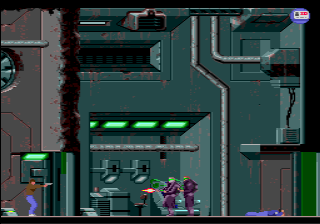Flashback, released as Flashback: The Quest for Identity in the US, is a cinematic platformer developed by Delphine Software of France, a now defunct company, and published by U.S. Gold in United States and Europe, and Sunsoft in Japan. The game is listed in the Guinness World Records as the best-selling French game of all time.
Flashback was initially released for the Amiga in 1992, then ported to MS-DOS, Acorn Archimedes, Sega Mega Drive/Genesis and Super Nintendo in 1993. CD-ROM versions of Flashback for the 3DO, Apple Macintosh, Atari Jaguar, CD-i, FM Towns, MS-DOS and the Sega CD were released during 1994 and 1995.
Originally advertised as a "CD-ROM game on a cartridge", the game features fully hand-drawn backdrops and all animation is rotoscoped, giving movements a fluidity unusual for the time, similar to that of the earlier Prince of Persia. The rotoscoping technique of Flashback was invented independently of Prince of Persia, and used a more complicated method of first tracing video images onto transparencies.
The game is set in the year 2142 and details the journey of Conrad B. Hart, an agent for the Galaxia Bureau of Investigation, and his attempts to recover his lost memory to save the world.
By default, the DOS version has an extended introductory sequence and more minor cut scenes than the Amiga version, such as when picking up items. In the Amiga version, the user can see these scenes by enabling them (although with few seconds of delay every time the animations load) or by playing the game entirely from the hard drive. The Amiga version also had an option to zoom in on the action whenever Conrad opens fire. Due to criticism of the look, it was removed from all other versions. The message that Conrad writes in the ending was also different in this release.
The game was originally released on 3.5" floppy disk for MS-DOS. Re-releases on CD-ROM for 3DO, CD-i, PC, and Sega CD featured redone pre-rendered cinematic FMVs with audible dialog and sound. The Sega CD port also has voice work for gameplay and CD tracks for each level. The Jaguar port has the title screen that these ports have, but the music is different and the look of the title screen is all that it has from the CD releases.
In North America, the Sega Genesis, Super Nintendo and Sega CD versions featured a Marvel Comics comic book within the manual in order to explain the initial story. The PAL Sega Mega Drive and Super Nintendo releases (There was no Mega-CD version.) omitted the comic and instead featured a textual prologue.
The Super Nintendo port was also censored, with New Washington's bar becoming a cafe and Death Tower being renamed Cyber Tower.
 Flashback was and still appears to be mistaken as a sequel to Eric Chahi's videogame Another World. Although both games do share similarities, the storylines are completely different, and there is no major connection between two characters in Flashback. Flashback is mistaken as a sequel for the following reasons:
Flashback was and still appears to be mistaken as a sequel to Eric Chahi's videogame Another World. Although both games do share similarities, the storylines are completely different, and there is no major connection between two characters in Flashback. Flashback is mistaken as a sequel for the following reasons:- Both games are published by Delphine.
- Another World also utilizes rotoscoped animation. Flashback's graphics are similar to Another World, but the gameplay backgrounds are digitized hand-done drawings, while the vectors are pre-rendered compared to Another World, which featured real-time polygons all over, though the 3DO port did have digitized hand-painted backgrounds.
- The gameplay of Flashback is based on Another World, but Flashback has step-based controls and also had a heads-up display while Another World didn't have any of these.
So this has been released on the IPhone and I really think you should check it out if you already haven't

No comments:
Post a Comment